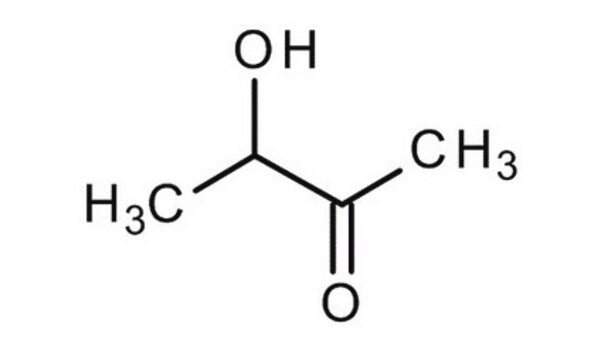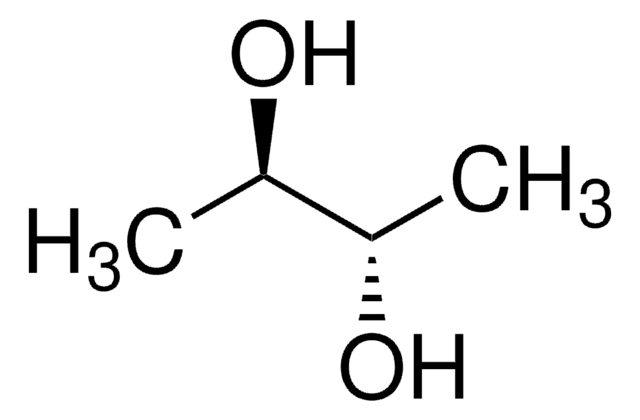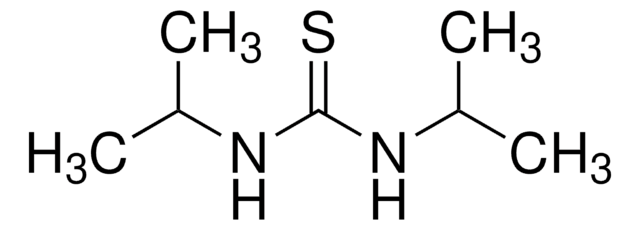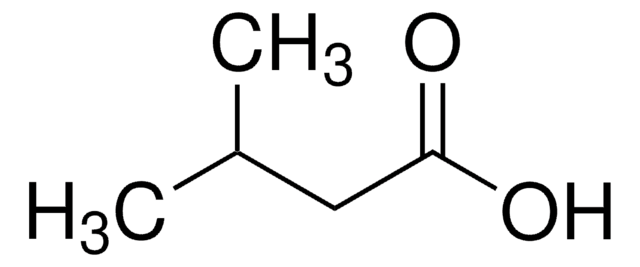Wichtige Dokumente
W200808
3-Hydroxy-2-butanon
primarily dimer, ≥95%, FG
Synonym(e):
Acetoin, Acetylmethylcarbinol
About This Item
Empfohlene Produkte
Biologische Quelle
synthetic
Qualitätsniveau
Qualität
FG
Fragrance grade
Halal
Kosher
Agentur
follows IFRA guidelines
Einhaltung gesetzlicher Vorschriften
EU Regulation 1223/2009
EU Regulation 1334/2008 & 178/2002
FDA 21 CFR 117
FDA 21 CFR 182.60
Assay
≥95%
Brechungsindex
n20/D 1.417 (lit.)
bp
148 °C (lit.)
mp (Schmelzpunkt)
15 °C (monomer)
90 °C (dimer) (lit.)
Löslichkeit
acetone: soluble(lit.)
water: soluble(lit.)
Dichte
1.013 g/mL at 25 °C (lit.)
Anwendung(en)
flavors and fragrances
Dokumentation
see Safety & Documentation for available documents
Nahrungsmittelallergen
no known allergens
Allergener Duftstoff
no known allergens
Organoleptisch
butter; creamy; cheesy
Lagertemp.
2-8°C
SMILES String
CC(O)C(C)=O
InChI
1S/C4H8O2/c1-3(5)4(2)6/h3,5H,1-2H3
InChIKey
ROWKJAVDOGWPAT-UHFFFAOYSA-N
Suchen Sie nach ähnlichen Produkten? Aufrufen Leitfaden zum Produktvergleich
Verwandte Kategorien
Allgemeine Beschreibung
Anwendung
- Role of Volatile Organic Compounds Produced by Kosakonia cowanii Cp1 during Competitive Colonization Interaction against Pectobacterium aroidearum SM2.: Diese Studie untersucht die Rolle flüchtiger organischer Verbindungen, einschließlich Acetoin, die von Kosakonia covanii CP1 bei der Hemmung von Pectobacterium aroidearum SM2 hergestellt werden, und hebt das Potenzial von Acetoin für Anwendungen in der Biokontrolle hervor (Mena Navarro et al., 2024).
- Chemical imitation of yeast fermentation by the drosophilid-pollinated deceptive trap-flower Aristolochia baetica (Aristolochiaceae).: Die Forschungsarbeit untersucht, wie Aristolochia baetica die Hefefermentierung imitiert, einschließlich der Produktion von Acetoin, um Drosophiliden-Bestäuber anzuziehen und nd unterstreicht die Rolle von Acetoin bei der Interaktion zwischen Pflanzen und Bestäubern (Rupp et al., 2024).
- Investigating the impact of various sorghum types on the key aroma compounds of Sichuan Xiaoqu Baijiu through application of the sensomics approach.: In dieser Studie wird untersucht, wie verschiedene Sorghum-Arten die wichtigsten Aromaverbindungen, einschließlich Acetoin, in Sichuan Xiaoqu Baijiu beeinflussen, was die Bedeutung von Acetoin in den Geschmacksprofilen von Lebensmitteln und Getränken belegt (Ma et al., 2024).
- Regulation of Tetramethylpyrazine Formation by the Phenolics-Fenton Coupled Redox Cycling System.: Die Forschungsarbeit untersucht die biochemischen Signalwege, die von Acetoin bei der Bildung von Tetramethylpyrazin reguliert werden, und liefert Erkenntnisse über seine Rolle bei der Geschmacksstoff-Biosynthese (Xu et al., 2024).
- Design of a synthetic enzyme cascade for the in vitro fixation of formaldehyde to acetoin.: In dieser Arbeit wird die Entwicklung einer synthetischen Enzymkaskade zur Umwandlung von Formaldehyd in Acetoin vorgestellt, die sein Potenzial in biotechnologischen Anwendungen für die Entgiftung von Formaldehyd zeigt (Cui et al., 2024).
Rechtliche Hinweise
Signalwort
Warning
H-Sätze
Gefahreneinstufungen
Eye Irrit. 2 - Flam. Sol. 2 - Skin Irrit. 2
Lagerklassenschlüssel
4.1B - Flammable solid hazardous materials
WGK
WGK 1
Persönliche Schutzausrüstung
Eyeshields, Gloves, type P3 (EN 143) respirator cartridges
Hier finden Sie alle aktuellen Versionen:
Besitzen Sie dieses Produkt bereits?
In der Dokumentenbibliothek finden Sie die Dokumentation zu den Produkten, die Sie kürzlich erworben haben.
Kunden haben sich ebenfalls angesehen
Protokolle
-Cymene; 2,5-Dimethylpyrrole; Acetoin, ≥96%, FCC, FG; 2,5-Dimethylpyrazine; 2,6-Dimethylpyrazine; 2-Ethylpyrazine, ≥98%, FG; 2,3-Dimethylpyrazine; 4-Heptanone; 3-Ethylpyridine; 2,3,5-Trimethylpyrazine; Furfural; Pyrrole; Furfuryl acetate; Linalool; Linalyl acetate; 5-Methylfurfural; γ-Butyrolactone; 2-Acetyl-1-methylpyrrole; Furfuryl alcohol; 2-Acetylpyrrole; Pyrrole-2-carboxaldehyde
Unser Team von Wissenschaftlern verfügt über Erfahrung in allen Forschungsbereichen einschließlich Life Science, Materialwissenschaften, chemischer Synthese, Chromatographie, Analytik und vielen mehr..
Setzen Sie sich mit dem technischen Dienst in Verbindung.












